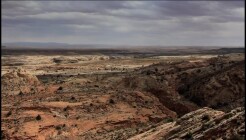Roz Mortimer, Sites of Memory (2012)
Medium: Video Painting, Projection, Color and no sound
Dimensions: 34 Scapes | Duration: 3 hours, 29 min., 52 sec.
Collection: Video Painting Solo Series
Edition of 7
Reference: VPSS-RMSM12
This series of video paintings comes out of a larger body of work exploring notions of landscape and memory. Created during 2011 and 2012 in the American West, Central Europe and the UK, each video painting is linked to a specific event: battlefields, shipwrecks, ghost towns, massacres, concentration camps, sacred lands, earthquake sites, abandoned homes.
In these works it is the tension between the history of each place and the indexical link Mortimer has standing at each site that interests her. History becomes collapsed. The landscapes, whether they are epic or banal, take on the memory of past peoples and past events. During the spring of 2011 Mortimer spent four months living in a small town in Montana. The American West is a place that is considered ‘young’ in historical terms, yet this is a definition from the settlers’ perspective. It is actually a place that is rich in history and imbued with memory...memory of people and of cultures. Much is controlled in how this part of the world is historicized and memorialized. The video paintings in this collection take us to places like the battlefields of The Little Bighorn in Montana, sacred Navajo sites in Utah and ghost towns in Idaho, forming a portrait of the West that raises questions about the construction of history.
Later that year Mortimer travelled to Central Europe to create a number of video paintings of WWII sites in Hungary and Poland. These are lakes, forests and abandoned railway stations which are intrinsically linked to the Holocaust. Dark landscapes that have hidden histories, their lack of memorialization the result of cultural amnesia. The series also includes work created in the UK. Here Mortimer is focusing on the relationship between landscape and the sublime. These are sites of natural disasters and romanticized history, from Cornish shipwrecks to flooded suburban bungalows on the Essex coast, standing circles and an ancient chapel buried under a sand dune.







